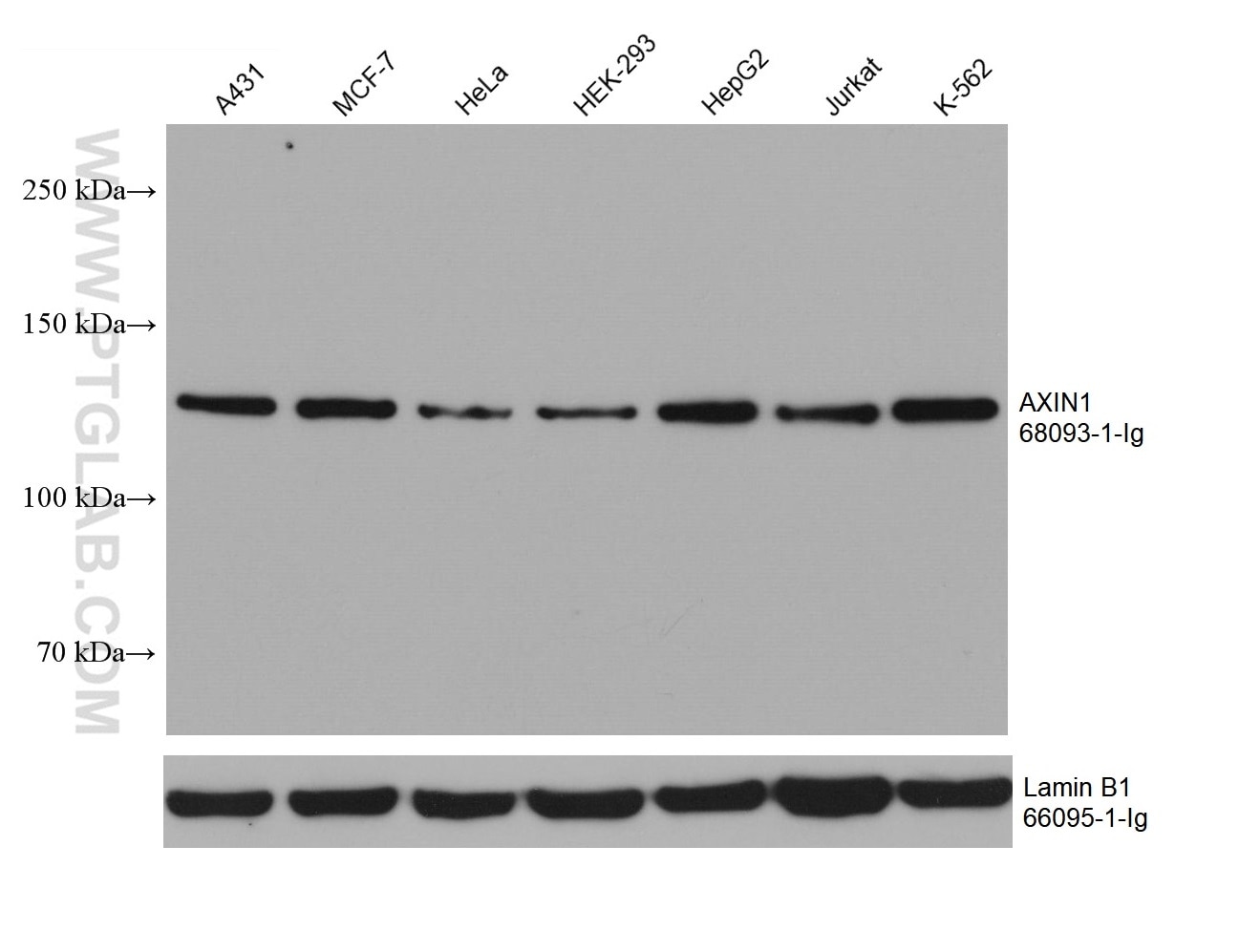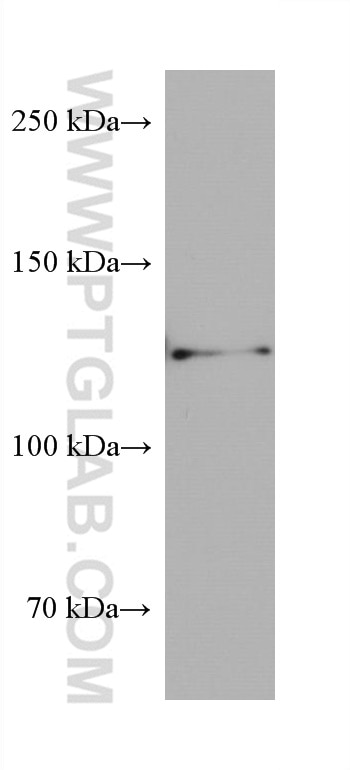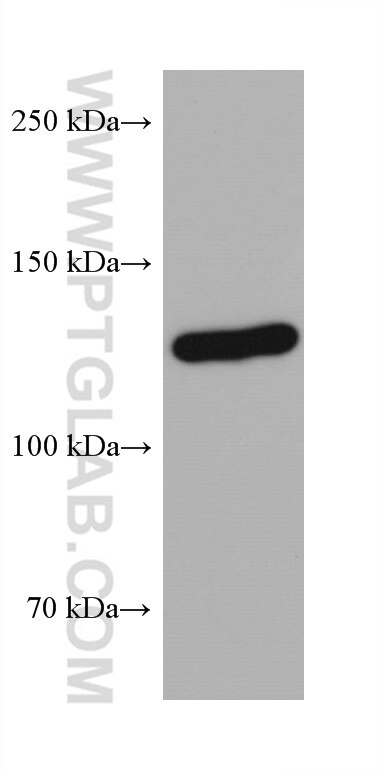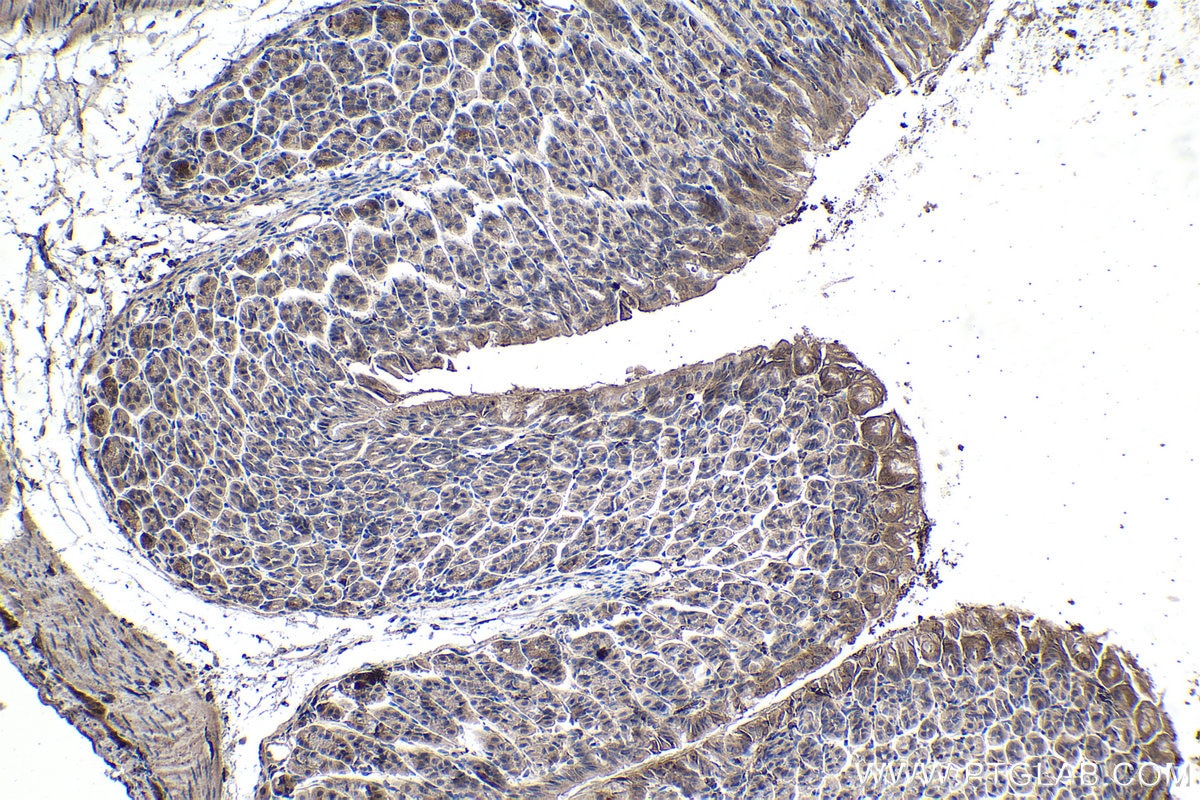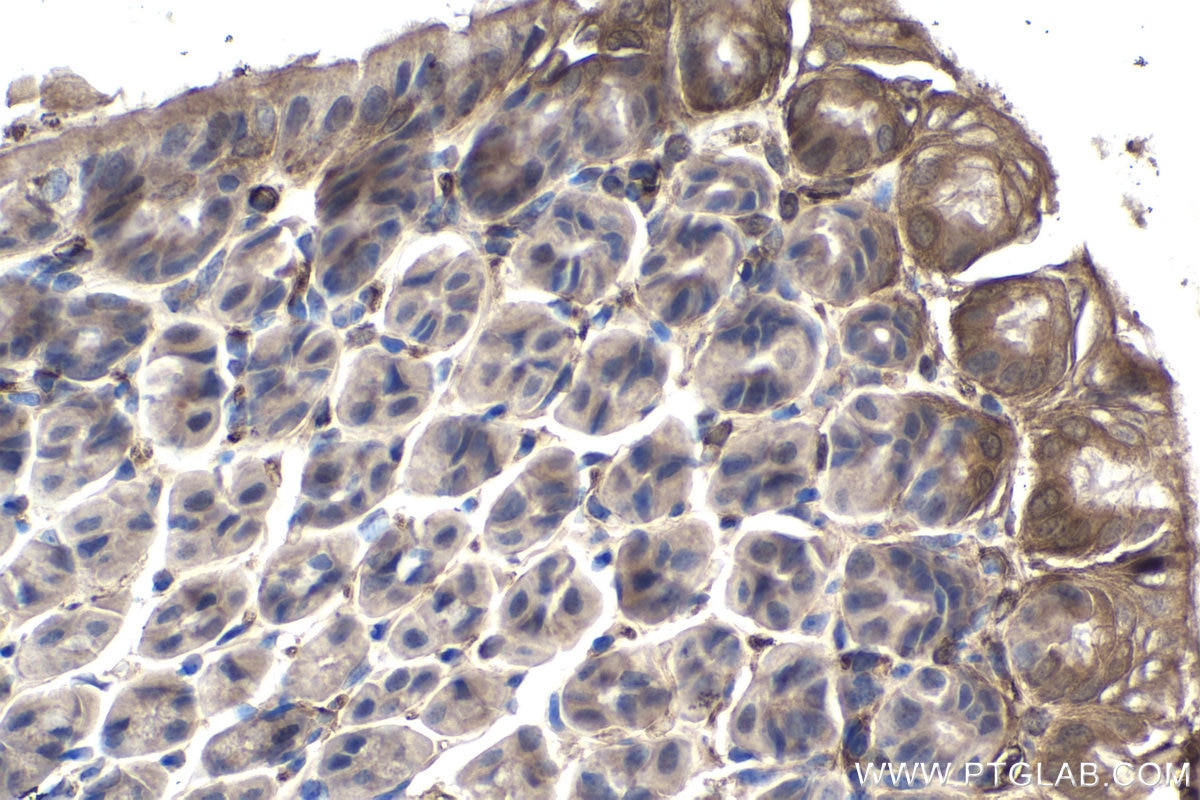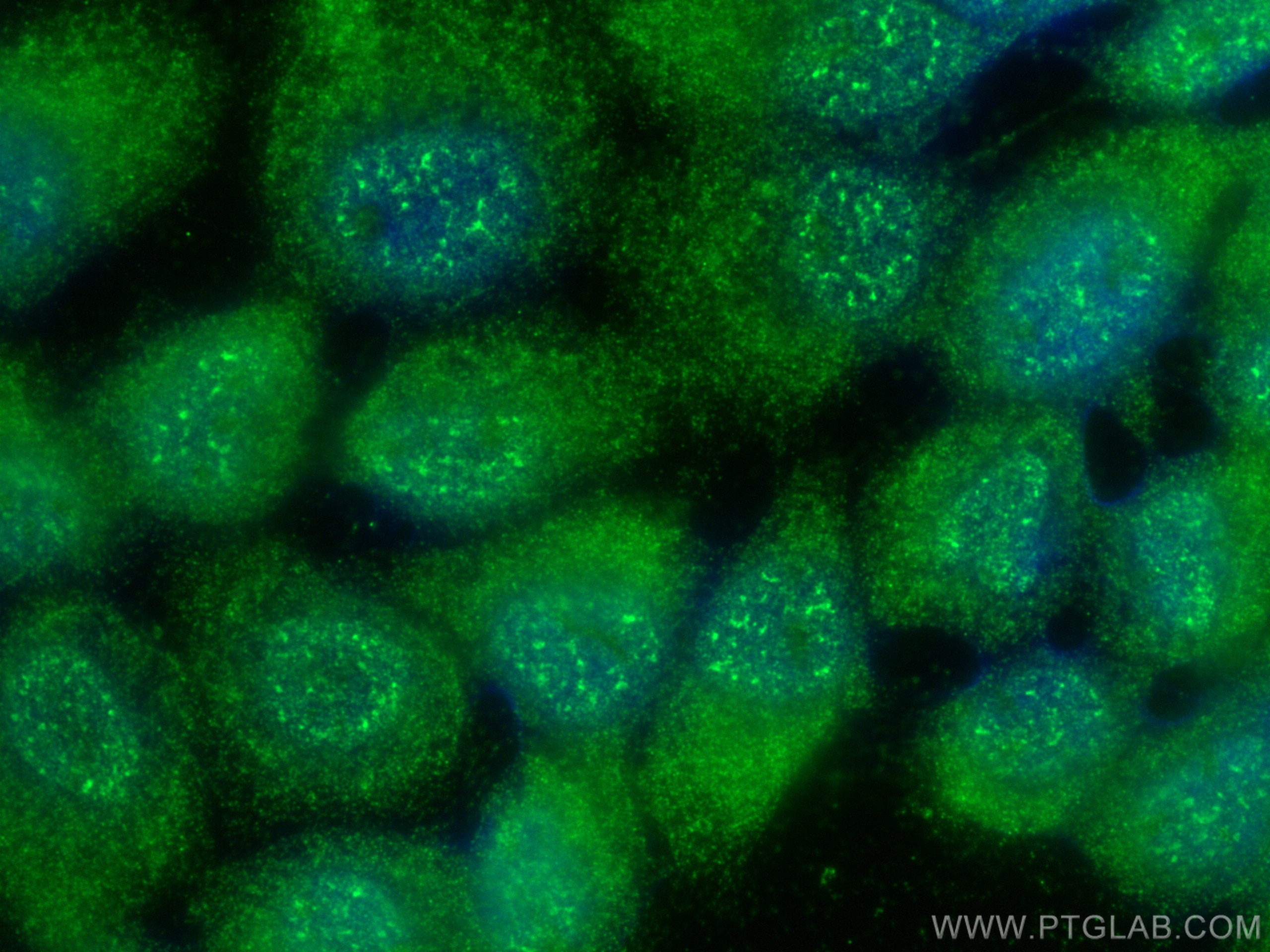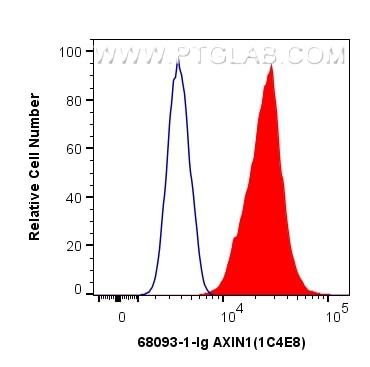AXIN1 Monoklonaler Antikörper
AXIN1 Monoklonal Antikörper für WB, IHC, IF/ICC, FC (Intra), ELISA
Wirt / Isotyp
Maus / IgG1
Getestete Reaktivität
human, Maus, Ratte
Anwendung
WB, IHC, IF/ICC, FC (Intra), ELISA
Konjugation
Unkonjugiert
CloneNo.
1C4E8
Kat-Nr. : 68093-1-Ig
Synonyme
Geprüfte Anwendungen
| Erfolgreiche Detektion in WB | A431-Zellen, HEK-293-Zellen, HeLa-Zellen, HepG2-Zellen, Jurkat-Zellen, K-562-Zellen, MCF-7-Zellen, NIH/3T3-Zellen |
| Erfolgreiche Detektion in IHC | Maus-Magengewebe Hinweis: Antigendemaskierung mit TE-Puffer pH 9,0 empfohlen. (*) Wahlweise kann die Antigendemaskierung auch mit Citratpuffer pH 6,0 erfolgen. |
| Erfolgreiche Detektion in IF/ICC | A431-Zellen |
| Erfolgreiche Detektion in FC (Intra) | A431-Zellen |
Empfohlene Verdünnung
| Anwendung | Verdünnung |
|---|---|
| Western Blot (WB) | WB : 1:5000-1:50000 |
| Immunhistochemie (IHC) | IHC : 1:1000-1:4000 |
| Immunfluoreszenz (IF)/ICC | IF/ICC : 1:200-1:800 |
| Durchflusszytometrie (FC) (INTRA) | FC (INTRA) : 0.40 ug per 10^6 cells in a 100 µl suspension |
| It is recommended that this reagent should be titrated in each testing system to obtain optimal results. | |
| Sample-dependent, check data in validation data gallery | |
Veröffentlichte Anwendungen
| WB | See 3 publications below |
| IF | See 1 publications below |
Produktinformation
68093-1-Ig bindet in WB, IHC, IF/ICC, FC (Intra), ELISA AXIN1 und zeigt Reaktivität mit human, Maus, Ratten
| Getestete Reaktivität | human, Maus, Ratte |
| In Publikationen genannte Reaktivität | human |
| Wirt / Isotyp | Maus / IgG1 |
| Klonalität | Monoklonal |
| Typ | Antikörper |
| Immunogen | AXIN1 fusion protein Ag10079 |
| Vollständiger Name | axin 1 |
| Berechnetes Molekulargewicht | 826aa,92 kDa; 862aa,95 kDa |
| Beobachtetes Molekulargewicht | 110-120 kDa |
| GenBank-Zugangsnummer | BC044648 |
| Gene symbol | AXIN1 |
| Gene ID (NCBI) | 8312 |
| Konjugation | Unkonjugiert |
| Form | Liquid |
| Reinigungsmethode | Protein-G-Reinigung |
| Lagerungspuffer | PBS with 0.02% sodium azide and 50% glycerol |
| Lagerungsbedingungen | Bei -20°C lagern. Nach dem Versand ein Jahr lang stabil Aliquotieren ist bei -20oC Lagerung nicht notwendig. 20ul Größen enthalten 0,1% BSA. |
Hintergrundinformationen
Axis inhibition protein1 (AXIN1), also called AXIN, together with AXIN2 are multidomain scaffold proteins that negatively regulate Wnt signaling. AXIN1 is likely to function as a tumor suppressor. Under UV irradiation, AXIN1-HIPK2-TP53 complex forms. The complex also controls cell growth, apoptosis and development. Like AXIN2, AXIN1 undergoes poly(ADP-ribosy)lation by tankyrase TNKS and TNKS2 followed by unbiquitination by RNF146 which leads to its degradation and subsequent activation of Wnt signaling. Its deubiquitination by USP34 is important for nuclear accumulation during Wnt signaling. Recent researches find that CircAXIN1 encodes a novel protein, AXIN1-295aa, which shows at around 40-55 kDa by Western Blot. AXIN1-295aa functions as an oncogenic protein, activating the Wnt signaling pathway to promote GC tumorigenesis and progression, suggesting a potential therapeutic target for GC.
Protokolle
| PRODUKTSPEZIFISCHE PROTOKOLLE | |
|---|---|
| WB protocol for AXIN1 antibody 68093-1-Ig | Protokoll herunterladen |
| IHC protocol for AXIN1 antibody 68093-1-Ig | Protokoll herunterladenl |
| IF protocol for AXIN1 antibody 68093-1-Ig | Protokoll herunterladen |
| FC protocol for AXIN1 antibody 68093-1-Ig | Download protocol |
| STANDARD-PROTOKOLLE | |
|---|---|
| Klicken Sie hier, um unsere Standardprotokolle anzuzeigen |
Publikationen
| Species | Application | Title |
|---|---|---|
Int Immunopharmacol Preliminary investigation on the mechanism of baicalein regulating the effects of Nischarin on invasion and apoptosis of human breast cancer cells MCF-7 through Wnt3α/β-catenin pathway | ||
Biochem Pharmacol SMURF1 leads to the β-catenin signaling-mediated progression of esophageal squamous carcinoma by losing PATZ1-induced CCNG2 transcription | ||
Int J Biol Macromol Xylooligosaccharides alleviate the carbohydrate-enriched diet-induced intestinal barrier dysfunction in carp Megalobrama amblycephala by promoting intestinal development, immunity and gut microbiota |
